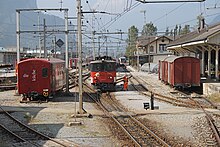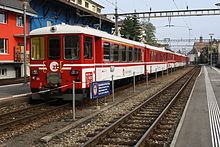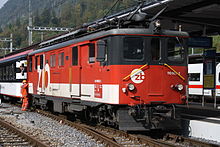Zentralbahn
| e.g. Zentralbahn AG
|
|
|---|---|
| legal form | Corporation |
| founding | 1897, (name change 2005) |
| Seat | Stansstad , Switzerland |
| management | Michael Schürch (Managing Director) Toni Häne ( Chairman of the Board of Directors ) |
| Number of employees | 323/305 FTE / 19 apprentices (2013) |
| Branch | Transport company |
| Website | www.zentralbahn.ch |

The Zentralbahn ( zb ) is a Swiss railway company that arose from the integration of the Brünigbahn of the SBB into the Luzern-Stans-Engelberg-Bahn (LSE) on January 1, 2005. The company is based in Stansstad . It operates the meter-gauge Brünigbahn ( Lucerne - Interlaken Ost) and the meter-gauge Luzern - Stans - Engelberg- Bahn.
history
In 1888, the Jura – Bern – Lucerne (JBL) opened the Brünig Railway from Brienz via the Brünig Pass to Alpnachstad , connecting Lake Brienz and Lake Lucerne . A year later the line was extended to Lucerne, in 1916 to Interlaken Ost on the other side. During the Second World War, the line was electrified and electrical operation began in 1941/42. The JBL later became part of the Jura-Simplon Railway (JS) and this was nationalized in 1903.
On October 10, 1890, the initiative committee was granted the concession for a railway line from Stansstad to Engelberg. On January 27, 1897 the railway company Elektro Bahn Stansstad – Engelberg (StEB) was established. The line was opened on October 5, 1898. Because the company could not pay the interest on the debt, some bondholders demanded compulsory liquidation in 1957. This could be averted by buying up the majority of the bonds through the savings fund Nidwalden.
Since the line ended in Stansstad on Lake Lucerne, the government of Nidwalden applied for a license in 1951 for a connection to Hergiswil with a connection to the SBB Brünigbahn . This concession was granted in 1956 and in 1959 the Federal Assembly approved a federal contribution, which allowed construction work to begin. In 1964, the connection between Stansstad and Hergiswil was opened with integration into the Brünigbahn station and a complete renovation of the existing route with adaptation to the Brünigbahn standard components was completed. Now direct trains from Lucerne could be run using the Brünigbahn section. The StEB, which was also financially renovated, took on the name Luzern-Stans-Engelberg-Bahn (LSE) when it was put back into operation.
On June 30, 2004, the Federal Council authorized SBB to sell the Brünigbahn to the LSE. The LSE license was then extended to the Brünig Railway. Since the Brünigbahn of SBB was not an independent company, there is no real merger , but an expensive merger. In a first step, LSE changed its name in December 2004 to eg Zentralbahn AG. As a result, a capital increase was carried out in which the SBB subscribed shares and paid them in through the de facto cession of the Brünigbahn (infrastructure and rolling stock). The resulting new company operates independently, but two thirds of it is owned by SBB. The other shareholders are the federal government , the cantons of Nidwalden , Obwalden and the municipality of Engelberg . Only 5% of the shares are privately owned.
The reasons for the merger at that time were the upcoming, large investments in rolling stock and infrastructure, which each railway could not have carried alone. Since the track width of exactly one meter and the section between Lucerne and Hergiswil are also identical, this merger was a logical step if you didn't want to risk the existence of one of the two railways.
A similarly named railway company was integrated into the SBB as early as 1902: the Swiss Central Railway .
In December 2010, the 4043 meter long Engelberg tunnel between Grafenort and Boden was opened to traffic. The new building reduced the travel time from Lucerne to Engelberg by 14 to 47 minutes.
On November 12, 2012, the new section between Lucerne train station and Kriens-Mattenhof was opened to traffic. The centerpiece is the 1325 meter long double-lane Allmend tunnel . It replaces the approximately 1.4 kilometers longer, above-ground entrance to Lucerne train station with four level crossings. In addition, with the new underground stop Lucerne Allmend / Messe , which opened on December 9, 2012, the south of Lucerne with the Swissporarena and exhibition center was better developed. Also, almost all train stations and the entire route network have been completely renewed in the last 10 years. The flood of the century in 2005 also played a decisive role, as 80% of the entire route network could no longer be used at that time.
In August 2014 there was a fatal accident at the Allmend level crossing in Wolfenschiessen . A minibus carrying Israeli tourists was hit by a train while crossing. Three of the eight inmates died; some of the others were seriously injured. The crossing was only marked with a St. Andrew's cross and not secured with a barrier . At the time of the accident, there were still 32 of these crossings in the area of the community of Wolfenschiessen. Such transitions in Switzerland must either be canceled or secured by the end of 2015. The Swiss Federal Office of Transport originally set a deadline of the end of 2014. Based on submissions from railway companies, this was extended to the end of 2015.
From 2005 to 2011 Josef Langenegger was managing director of Zentralbahn. He was instrumental in the merger of the Brünigbahn with the Luzern-Stans-Engelberg-Bahn.
From 2011 to 2016 Renato Fasciati was Managing Director of Zentralbahn. During this time, several infrastructure projects were implemented and new rolling stock was put into operation. Michael Schürch has been at the helm of the company since July 2016.
Rolling stock
Since the Zentralbahn was not a completely new company, the rolling stock of the predecessor railways was taken over. The first “new vehicles” from ZB were the ten Spatz multiple units (type ABe 4/8) still ordered by SBB for Stadler Rail . These went into operation successively from the end of 2004 and already had the corporate design of Zentralbahn ex works. Also in 2005, a new Stadler HGm 2/2 diesel-electric rack-and-pinion locomotive was put into operation.
The three articulated control vehicles (type ABt) from Stadler, which were still ordered by LSE, were put into operation from 2006. The vehicles, which are visually very similar to the Spatz multiple units, were procured for operation through the Stocktunnel (colloquially “Tunnel Engelberg”), the completion of which was delayed for several years. Until the tunnel was put into operation in December 2010, the articulated control cars were usually used together with the Sparrows on the S-Bahn lines from Lucerne.
For operation on the former LSE route to Engelberg, the newer vehicles from the existing rolling stock park are used and partially modernized (fire protection measures). Locomotive shuttle trains with HGe 4/4 II , articulated control cars (941-943) and the newer cars from the LSE have been running to Engelberg since December 2010. After the delivery of the new multiple units for the Brünig, the two panorama cars were added.
In September 2009 Zentralbahn ordered four seven-part Adler type ABeh 150 multiple units (126 m long) and six three-part Fink type ABeh 160 from Stadler Rail. The multiple units, which cost around 141 million Swiss francs, have an adhesion drive and a separate gear drive. The eagle consists of two three-part multiple units, each with a driver's cab and a non-powered dining car lined up in between. Commercial use of the first delivered trains began on September 22, 2012.
All eagles and finches have been in use since the timetable change in December 2013 . While the Adler is used for the Lucerne – Interlaken Express, the Fink is very versatile: on the one hand during commuter times as a relief train, then during the day as a reinforcement to the Adler over the Brünig and in the evening for the Lucerne – Engelberg Express to Engelberg . The fact that the sparrows were equipped with Schwab couplings at a later date means that both vehicles will also run together on the S-Bahn. With the 2014 timetable change, the new rolling stock made it possible to introduce an integral quarter-hour cycle between Lucerne and Hergiswil, new direct connections between Lucerne and Stans and Sarnen, as well as reduced travel times between Lucerne and Interlaken. In autumn 2014, Zentralbahn was also able to order five more finches , which will replace the more than 40-year-old modules from autumn 2016, which currently strengthen the sparrows in S-Bahn traffic during commuter times. They are called ABeh 161 and are almost identical. Another order for two eagles to replace the HGe-GSW pendulum and seven finches has been received by Stadler . The vehicles are to be delivered from 2022.
Rack sections
There are five rack sections on the Zentralbahn network, four on the Brünigbahn and the Mettlen – Boden section on the route to Engelberg:
| section | from km | up to km | length | Max. Tilt |
|---|---|---|---|---|
| Giswil - Kaiserstuhl | 29,444 | 31.812 | 2,368 m | 102 ‰ |
| Lung - Chäppeli | 35,900 | 37.590 | 1 690 m | 105 ‰ |
| Chäppeli - Brünig-Hasliberg | 38.773 | 39,962 | 1 189 m | 110 ‰ |
| Brünig-Hasliberg - Meiringen | 40.270 | 44.122 | 3 852 m | 128 ‰ |
| Mettlen - soil | 18,871 | 22.668 | 3 797 m | 105 ‰ |
| Sum of rack sections | 12 896 m |
gallery
literature
- Peter Berger, Hans Waldburger, Christoph Berger: Railways to Engelberg. 100 years of rail transport from Lake Lucerne to the monastery village. Minirex, Lucerne 1998, ISBN 3-907014-10-3 .
Web links
- Official website of the Zentralbahn
- Project: Expansion of the central railway in Lucerne and Hergiswil
Individual evidence
- ↑ In the commercial register, the license date is incorrectly entered as the first statutory date, see commercial register of the canton of Nidwalden, entry e.g.
- ↑ Annual reports , on the Zentralbahn website, accessed on March 26, 2018
- ↑ Renato Fasciati: Ten years of the Zentralbahn - from the provincial railway to one of the most modern meter- gauge railways in Europe . In: Eisenbahn-Revue International . No. 8–9 , 2015, pp. 410-415 .
- ↑ The Engelberg Tunnel , on the Zentralbahn website, accessed on April 4, 2015
- ↑ Discontinued railways in Switzerland
- ^ Subscription Lucerne. In: Zentralbahn. Archived from the original on July 22, 2013 ; Retrieved November 4, 2012 .
- ↑ Erich Aschwanden: A level crossing becomes a death trap. Neue Zürcher Zeitung , August 11, 2014, accessed on August 12, 2014.
- ^ Josef Langenegger: Zentralbahn managing director resigns in 2011 , article from September 16, 2010 on bahnonline.ch, accessed on October 15, 2018
- ↑ Yes to the procurement of rolling stock. December 19, 2019, accessed March 1, 2020 .
- ↑ Infrastructure data e.g. Zentralbahn AG. Zentralbahn, Stansstad, 1st January 2016










